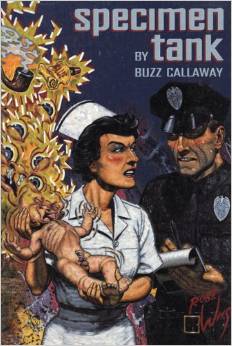THE HISTORIE OF KUIPER BELT INDUSTRIES: GEORGE COOPER
In the early twenty-first century the billionaires Musk, Branson and Bezos were celebrity space entrepreneurs. But it was a man virtually unknown at the time, George Cooper the First, called by his heirs The First, who took an old, rust belt, Oil Age, analogic behemoth and transubstantiated it into Kuiper Belt Industries, a company whose logo has since been planted on every rock from the Sun to Proxima Centauri B.
When George Cooper the First was born in 1960 the Cooper Belt Corporation was a conservatively diversified company that still manufactured drive belts. Wherever there were belts and gears the belts likely came from Cooper factories located in Ohio, Indiana and Michigan. The Cooper Belt Corporation had its start in the early 19th century when a Scots Irish immigrant, Donald Cooper, opened a barrel business in New York. He got into shipping but was bankrupted by Cornelius Vanderbilt. He moved to Ohio and bought a factory that made drive belts for mills. The son expanded the business, speculated in oil and opened plants across the midwest producing not just belts but gears, chains, motors and other parts for automobiles and appliances. The Cooper Belt Corporation grew mighty and its trunk supported several branches of the family, but the Coopers, handing the reins down son-to-son, retained close control and it was never publicly traded. George the First’s grandfather Kaerl Cooper profited from the Second World War while his father, Kaerl Junior (just Junior in the family, often with a sneer, as at that point there was competition between dilletantes for chief imbecile), a gentle man with no head for business, but a love of baseball, art and symphonic music, relied on his managers to keep things going. He endowed and built a home in Cleveland for the Cooper Collection of Modern Art, and was annually guest conductor of the Cleveland Orchestra in Severance Hall.
In 1954 Gordon Teal, working for the newly formed Texas Instruments Corporation, created the first commercial silicon transistor. Teal came to Dayton, Ohio in May of that year to present his paper: Some Recent Developments in Silicon and Germanium Materials and Devices to the Institute of Radio Engineers’ National Conference on Airborne Electronics. By the end of the year TI had produced the first transistor radio. A young Cooper Belt Corporation financial adviser, Imogen Smiley, MIT graduate in engineering and ham radio enthusiast, attended the Dayton conference and left convinced that consumer electronics and communications would define the second half of the twentieth century as industrial manufacturing had defined the first half. But she could not persuade the old men who controlled the company to make the move and instead invested her own money in TI and other semi-conductor manufacturers. In 1965 she married a charming alcoholic gambler and con man named Nelson Kavanagh and had a daughter, Imogen 2. She had an affair with Junior and became pregnant. When he demanded she have an abortion she promised she would but had the baby in secret, naming her Io Smiley. This was George the First’s half sister but he was not to meet her or know of her existence. Imogen sent her to be raised by relatives in Virginia. All she kept of her was a vial of blood, labeled and stored in a cryovac facility. That blood founded the line of Iocle and Sara Istar.
George the First grew up in the family home outside of Cleveland, a 40,000 square foot rambling mansion with turrets and widow walks on 50 acres of landscaped property. Here in his languid and lonely childhood of pet giraffes and chauffeured limousines he became obsessed with outer space. He saw 2001: A Space Odyssey on a private screen and, accompanied by his adoring father, went to Florida to watch every Gemini and Apollo mission launch. He built models of the Saturn 5 rocket. An indifferent student, he was nevertheless fascinated by physics and engineering. In 1982 he graduated near the middle of his class from Harvard and went to work for Imogen Smiley. Unlike his father’s advisors he was eager to get into the game, even if it seemed too late. They bought a small company in California producing parts under contract to NASA for the aerospace industry. They grew close, and had a brief affair, despite the 30-year age difference and her prior affair with his father. Things became more complicated when George and Imogen 2 fell in love and secretly married, afraid of her mother’s reaction. Imogen was not pleased but realized this would cement the union between their families and that her daughter and son-in-law would produce the heir to Cooper Belt Corporation. She did not forget Io Smiley.
In his late fifties the First found himself in a crowded field of men whose names were household words. Cooper was a mouse among dinosaurs and like the mouse, he bided his time. Space tourism didn’t interest him. Industrial production was too risky given the costs. The most tantalizing prize of all, colonizing Mars, was to his eyes pointless and best done by others. But he would certainly be happy to outfit anyone fool enough to try.
He had become cynical. Mars had betrayed him. As a boy the romance of adventure and the myth of the cosmos drove his obsession. The planets were like people in his mind, spheres with personalities and attitudes. He named the hills where he played after the Tharsas volcanoes of Mars. When it became evident he wouldn’t be an astronaut he fantasized that he would build the first rocket to send people there, that the glory of conquest would be George Cooper’s. Over the decades, as satellites and probes returned actual data about the red planet, his hopes had to yield to the reality that Mars as it existed was inimical to human life. Its surface was not only cold but bombarded by radiation and covered in toxic perchlorate dust. Robotic exploitation of resources was cheaper and less risky. The science was rapidly evolving. He knew robotic beetles and cockroaches would one day scurry over the Valles Marineris. He bought controlling interests in a number of robotics firms.
Mars’ toxicity turned out to be a virtue. It would not matter what humanity did to this planet. There would be no limits, no authority. He could see what the future held. It was both exhilarating and depressing. Humans would set about the task of destroying Mars with the usual gusto. Consortiums would divvy up the planet, possession the only law. Convict labor would serve on prison factory ships in orbit about Mars, manufacturing mining robots. Within a hundred years the Martian surface would be studded with smokestacks belching frozen smoke as smelters turned out ingots of steel, aluminum, titanium and composite.
It would all depend on infrastructure. Cooper and Smiley decided to build it throughout the solar system, not just between Mars and Earth. They spun their aerospace company off of the stodgy Cooper Belt Corporation and called it Kuiper Belt Industries. To finance it he had a simple idea: create and feed a market for luxury goods produced not just in space but in its most remote reaches. The Kuiper Belt and the OOrt Cloud were home to primitive matter and the fact that it would take at least 20 years to deliver goods from that sector to the earth meant the wealthy would pay anything for it. First he would place satellites around every planet and create a solar sytem-wide communications and navigation network. In 2050 he launched yearly flights to the Kuiper Belt eventually becoming monthly. The ships would land on Trans Neptunian Objects, vacuum up material, and return to earth. The round trip time for the first vehicles was 20 years, 9 out, 9 back, with 2 years for collecting material. In the OOrt it can be years between objects. Each of these ships left behind rovers and helicopters operated by robots with evolving software.
In 2070, the year before his death, the first of these craft began to reach earth. By then the other space entrepreneurs were paying KBI for use of its infrastructure: satellites, orbiting labs, refueling stations, resupply depots. The research division was given broad latitude to speculate with future horizons of hundreds of years. They designed the Mars Elevator, and conceived of artificial moons and orbiting facilities as giant single-celled organisms. They produced prototype fusion propulsion systems that cut travel time for spacecraft, and sent out to habitable exoplanets the first gram-sized nano explorers, propelled by lasar arrays focused on solar sails, at 50% light speed. It was a tumultuous time in Earth history and as his space empire rose the earth fell into chaos. Hundreds of millions of people slaughtered each other while billions fled floods and tornadoes of fire. When he died at the age of 111, the earth was burning but KBI owned the solar system, and anyone wanting to get out, to explore, produce, export, import or live there in the future would pay his eponymous heir a cut.
George Cooper the Second was born in 1991 and was a very old man when Iago Vesuvius hired him to build the Monozone Inc. Genetic Seed Bank in Antarctica, a subterranean library of genetic material and plant seeds, licensed and patented as well as wild seed stock, ostensibly to preserve the genome of all domestic food crops and their wild progenitors. The Monozone Inc. complex included greenhouses and research facilities. But it also was home to all of the licensed genetic sequences developed for humans by Monozone Inc. over the decades. Iago Vesuvius was a renaissance man of the Late Oil Age, with a combined MD/PhD in biophysics and immunology from Stanford, a JD from Harvard Law and an MBA from the Wharton School. As the Director of Monozone Genetic Research and Development he successfully marketed synthetic genetic consumer products and the wrote the licensing agreements that allowed Monozone Inc. and other biotech giants to retain ownership and assert intellectual property rights over consumers who leased their synthetic genetic enhancements. Most of these packages were for cosmetic purposes, but included also enhanced intellectual and athletic ability and they carried options for heritability or single generation use. George the First and Second both purchased these packages for themselves and their children, who grew tall, with blue, almond shaped eyes, high cheekbones, and a tanned complexion, long powerful muscles, perfect pitch, and immunity to cancer and a host of other degenerative diseases, including a reversal of the aging process itself. The research and marketing were controversial, both among the wealthy few who chafed under the leasing agreements imposed upon them and the average people who were left out. Vesuvius’ plan ultimately was to use the Monozone Inc. Antarctic labs to perfect cloning technology, an operation banned by law and international convention. In 2148, at the age of 79, he cloned himself, naming the child after his grandfather, Emmanuel.
George Cooper the Second was aggressively building robotic infrastructure throughout the solar system, but unlike the First he was anxious to make the move to space. Life on Earth had become untenable. People yearned for escape and there were many ready to sell them their dreams. The Coopers would be there to supply the wherewithal. He did not have the field to himself, and industrial espionage was a real threat. Cooper 2 used the Monozone construction contract (which had State support) to build a secret R&D plant deep beneath the Antarctic ice to develop Martian colonization technologies. He became obsessed with deep drilling, and envisioned tunnels going down many kilometers, as any serious colonization required. He studied the properties of brines. And he built everything from domes to boring equipment, modular greenhouses and ways to generate energy, oxygen and detoxify soils, as well as developing human resource strategies that would allow survival without murder and suicide. The halls and hangar-sized facilities buzzed with robotic and human industry.
His son, George Cooper the Third, left Antarctica to build the first large scale human settlements on the Moon, Mars and Vesta. He went out with the crews, surveyed Mars himself from a light aircraft, operated a drone explorer on Vesta and actually walked on the moon. His grandfather was right. Mars was quickly overrun with wildcat mining operations, funded by promises of ‘diamonds lying around in the dirt.’ It wasn’t just polluted on the surface. The underground pods smelled like unwashed feet. He didn’t really care. It wasn’t his business what the idiots did with it. Cooper projects swarmed the solar system from the OOrt Cloud to Mercury. The Third George Cooper was famous for saying, to whomever would listen, Calculations show that just a gram of dust and gas in a cosmic cloud could contain as many as 10,000 trillion nanodiamonds.



